Cropland Loss Under Different Urban Expansion Patterns in China (1990–2020): Spatiotemporal Characteristics, Driving Factors, and Policy Implications
Abstract
1. Introduction
2. Study Area and Data
2.1. Study Area
2.2. Data
3. Methods
3.1. Identifying Urban Expansion Patterns
3.2. Analyzing Cropland Dynamics
3.3. Determining the Driving Forces of Cropland Change Under Different Urban Expansion Patterns
| Type | Drivers | Code | Unit | Reference |
|---|---|---|---|---|
| Natural ecological drivers | Digital Elevation Model | DEM | m | Qiao et al. [45] |
| Slope | Slope | ◦ | Qiao et al. [45] | |
| Change in NDVI | CNDVI | – | Wu et al. [44] | |
| Soil organic carbon | SOC | % | Qiao et al. [45] | |
| Temperature | CTEM | °C | Yu et al. [49] | |
| Change in precipitation | CPRE | mm | Yu et al. [49] | |
| River density | River | km/km2 | Qiao et al. [45] | |
| Socio-economic drivers | Road density | Road | km/km2 | Azadi et al. [43] |
| Change in nighttime light | CNTL | – | Hasan et al. [50] | |
| Change in urban intensity | CUI | – | Wu et al. [44] | |
| Change in GDP | CGDP | ¥/km2 | Tu et al. [3] | |
| Change in population density | CPOP | persons/km2 | Zhang et al. [51] |
4. Results
4.1. Spatiotemporal Dynamics of Urban Expansion Patterns
4.2. Spatiotemporal Dynamics of Cropland
4.3. Cropland Occupation Under Different Urban Expansion Patterns
4.4. Key Driving Factors of Cropland Changes Under Different Urban Expansion Patterns
5. Discussion
5.1. The Relationship Between Urban Expansion Patterns and Cropland Loss
5.2. Evolution of Dominant Drivers of Cropland Loss Under Different Expansion Patterns
5.3. Implications for Policy and Planning
5.4. Future Perspectives
6. Conclusions
- (1)
- Between 1990 and 2020, China’s rapid urban expansion led to a substantial loss of cropland. Among the three patterns, edge-spreading accounted for the largest share, with 78,549 km2 of cropland lost—63.1% of the total. This highlights the urgent need for stricter urban boundary control and enhanced enforcement of cropland protection policies in peri-urban areas.
- (2)
- CUI was the most important driver of cropland loss across three patterns, with SHAP values of 0.28 (leap-frogging), 0.37 (interior filling), and 0.38 (edge-spreading). Over time, the factors evolved from a singular emphasis on demographic and economic metrics to a more intricate combination of industrial development, environmental attributes, and spatial considerations. This transformation reflects the increasing complexity of urban expansion processes and their diverse impacts on cropland loss.
- (3)
- Differentiated policy measures are needed to address the cropland loss arising from each urban expansion pattern. For edge-spreading regions, stricter urban boundary controls and robust cropland protection policies are critical to safeguarding high-quality cropland. In interior filling areas, enhancing land use efficiency while preserving green spaces and remaining cropland is vital. For regions with regulated leap-frogging expansion, optimizing existing construction land and focusing development on lower-quality areas can reduce pressure on distant, productive cropland. These targeted strategies promote sustainable urbanization and cropland conservation.
Author Contributions
Funding
Data Availability Statement
Conflicts of Interest
References
- Li, F.; Wu, S.; Liu, H.; Yan, D. Biodiversity loss through cropland displacement for urban expansion in China. Sci. Total Environ. 2024, 907, 167988. [Google Scholar] [CrossRef]
- Ju, H.; Zhang, Z.; Zhao, X.; Wang, X.; Wu, W.; Yi, L.; Wen, Q.; Liu, F.; Xu, J.; Hu, S.; et al. The changing patterns of cropland conversion to built-up land in China from 1987 to 2010. J. Geogr. Sci. 2018, 28, 1595–1610. [Google Scholar] [CrossRef]
- Tu, Y.; Chen, B.; Yu, L.; Song, Y.; Wu, S.; Li, M.; Wei, H.; Chen, T.; Lang, W.; Gong, P.; et al. Raveling the nexus between urban expansion and cropland loss in China. Landsc. Ecol. 2023, 38, 1869–1884. [Google Scholar] [CrossRef]
- Deng, X.; Xu, X.; Cai, H.; Li, J. Assessment the impact of urban expansion on cropland net primary productivity in Northeast China. Ecol. Indic. 2024, 159, 111698. [Google Scholar] [CrossRef]
- Tu, Y.; Chen, B.; Yu, L.; Xin, Q.; Gong, P.; Xu, B. How does urban expansion interact with cropland loss? A comparison of 14 Chinese cities from 1980 to 2015. Landsc. Ecol. 2020, 36, 243–263. [Google Scholar] [CrossRef]
- Wu, X.; Zhao, N.; Wang, Y.; Zhang, L.; Wang, W.; Liu, Y. Cropland non-agriculturalization caused by the expansion of built-up areas in China during 1990–2020. Land Use Policy 2024, 146, 107312. [Google Scholar] [CrossRef]
- Forman, R.T.T. Land Mosaics: The Ecology of Landscapes and Regions; Cambridge University Press: Cambridge, UK, 1995. [Google Scholar]
- Liu, X.; Li, X.; Chen, Y.; Tan, Z.; Li, S.; Ai, B. A new landscape index for quantifying urban expansion using multi-temporal remotely sensed data. Landsc. Ecol. 2010, 25, 671–682. [Google Scholar] [CrossRef]
- Carol, E.H. Leapfrogging, urban sprawl, and growth management: Phoenix, 1950-2000. Am. J. Econ. Sociol. 2001, 60, 245–283. [Google Scholar]
- Hall, J. The Benefits and Costs of Urban Sprawl or Leapfrogging Urban Development; University of Western Sydney: Parramatta, Australia, 2009. [Google Scholar]
- Han, Y.; Qiao, D.; Zhang, Y.; Wang, J. Urban expansion dynamic and its potential effects on dry-wet circumstances in China’s national-level agricultural districts. Sci. Total Environ. 2022, 853, 158386. [Google Scholar] [CrossRef]
- Shrestha, M.K.; York, A.M.; Boone, C.G.; Zhang, S. Land fragmentation due to rapid urbanization in the Phoenix Metropolitan Area: Analyzing the spatiotemporal patterns and drivers. Appl. Geogr. 2012, 32, 522–531. [Google Scholar] [CrossRef]
- Tu, Y.; Chen, B.; Yu, L.; Xin, Q.; Gong, P.; Xu, B. Urban expansion driven farmland loss follows with the environmental Kuznets curve hypothesis: Evidence from temporal analysis in Beijing, China. In Geoinformatics in Sustainable Ecosystem and Society; Springer: Berlin/Heidelberg, Germany, 2019; pp. 394–412. [Google Scholar]
- Terfa, B.; Chen, N.; Liu, D.; Zhang, X.; Niyogi, D. Urban Expansion in Ethiopia from 1987 to 2017: Characteristics, Spatial Patterns, and Driving Forces. Sustainability 2019, 11, 2973. [Google Scholar] [CrossRef]
- Zhao, S.; Zhou, D.; Zhu, C.; Qu, W.; Zhao, J.; Sun, Y.; Huang, D.; Wu, W.; Liu, S. Rates and patterns of urban expansion in China’s 32 major cities over the past three decades. Landsc. Ecol. 2015, 30, 1541–1559. [Google Scholar] [CrossRef]
- Jia, L.; Ma, Q.; Du, C.; Hu, G.; Shang, C. Rapid urbanization in a mountainous landscape: Patterns, drivers, and planning implications. Landsc. Ecol. 2020, 35, 2449–2469. [Google Scholar] [CrossRef]
- Zhu, J. The formation of a market-oriented local property development industry in transitional China: A Shenzhen case study. Environ. Plann. A 1999, 31, 1839–1856. [Google Scholar] [CrossRef]
- Ranagalage, M.; Morimoto, T.; Simwanda, M.; Murayama, Y. Spatial Analysis of Urbanization Patterns in Four Rapidly Growing South Asian Cities Using Sentinel-2 Data. Remote Sens. 2021, 13, 1531. [Google Scholar] [CrossRef]
- Schneider, A.; Mertes, C.M.; Tatem, A.J.; Tan, B.; Sulla-Menashe, D.; Graves, S.J.; Patel, N.N.; Horton, J.A.; Gaughan, A.E.; Rollo, J.T.; et al. A new urban landscape in East–Southeast Asia, 2000–2010. Environ. Res. Lett. 2015, 10, 034002. [Google Scholar] [CrossRef]
- Meng, L.; Sun, Y.; Zhao, S. Comparing the spatial and temporal dynamics of urban expansion in Guangzhou and Shenzhen from 1975 to 2015: A case study of pioneer cities in China’s rapid urbanization. Land Use Policy 2020, 97, 104753. [Google Scholar] [CrossRef]
- Drake, E. The Leap-Frog Effect in the Context of Ontario’s Greenbelt: An Analysis of Farmland Loss in the Unprotected Countryside; University of Guelph: Guelph, ON, Canada, 2019. [Google Scholar]
- Zhou, K.; Liu, Y.; Tan, R.; Song, Y. Urban dynamics, landscape ecological security, and policy implications: A case study from the Wuhan area of central China. Cities 2014, 41, 141–153. [Google Scholar] [CrossRef]
- Tian, G.; Qiao, Z.; Gao, X. Rural settlement land dynamic modes and policy implications in Beijing metropolitan region, China. Habitat Int. 2014, 44, 237–246. [Google Scholar] [CrossRef]
- Xu, M.; He, C.; Liu, Z.; Dou, Y. How Did Urban Land Expand in China between 1992 and 2015? A Multi-Scale Landscape Analysis. PLoS ONE 2016, 11, e0154839. [Google Scholar] [CrossRef] [PubMed]
- Tarawneh, W.M.A. Urban sprawl on agricultural land litera. J. Environ. Earth Sci. 2014, 4, 97–124. [Google Scholar]
- Xu, Y.; Jia, R.; Liu, J.; Han, D.; He, T.; Xu, X.; Liu, L.; Sun, Z.; Qiao, Z. The population exposure risk of urban heat island effect: From the perspective of urban spatial expansion in China. Build. Environ. 2024, 258, 111565. [Google Scholar] [CrossRef]
- Ministry of Natural Resources of the People’s Republic of China. The Third National Land Survey; Ministry of Natural Resources of the People’s Republic of China: Beijing, China, 2021.
- Ma, L.; Long, H.; Tu, S.; Zhang, Y.; Zheng, Y. Farmland transition in China and its policy implications. Land Use Policy 2020, 92, 104470. [Google Scholar] [CrossRef]
- National Bureau of Statistics. Major Figures on 2020 Population Census of China; National Bureau of Statistics: Beijing, China, 2021. [Google Scholar]
- Zhou, Y.; Chen, T.; Feng, Z.; Wu, K. Identifying the contradiction between the cultivated land fragmentation and the construction land expansion from the perspective of urban-rural differences. Ecol. Inform. 2022, 71, 101826. [Google Scholar] [CrossRef]
- Yang, J.; Huang, X. The 30 m annual land cover dataset and its dynamics in China from 1990 to 2019. Earth Syst. Sci. Data 2021, 13, 3907–3925. [Google Scholar] [CrossRef]
- Han, J.; Han, F.; He, B.; Ma, X.; Wang, T. Spatiotemporal changes and driving factors of alpine land cover in Tianshan world natural heritage sites. Sci. Rep. 2024, 14, 20895. [Google Scholar] [CrossRef]
- Zhong, J.; Hao, L.; Sajinkumar, K.S.; Yan, D. Changes of ecological vulnerability in areas with different urban expansion patterns—A case study in the Yanhe river basin, China. J. Environ. Manag. 2024, 370, 122607. [Google Scholar] [CrossRef] [PubMed]
- Chen, Z.; Yu, B.; Yang, C.; Zhou, Y.; Yao, S.; Qian, X.; Wang, C.; Wu, B.; Wu, J. An extended time series (2000–2018) of global NPP-VIIRS-like nighttime light data from a cross-sensor calibration. Earth Sys. Sci. Data 2021, 13, 889–906. [Google Scholar] [CrossRef]
- Peng, L.; Huang, K.; Zhang, H.; Sun, W. Exploring the impacts of urbanization on vegetation growth from the perspective of urban expansion patterns and maturity: A case study on 40 large cities in China. Sustain. Cities Soc. 2024, 115, 105841. [Google Scholar] [CrossRef]
- Zhang, Y.; Shen, W.; Li, M.; Lv, Y. Assessing spatio-temporal changes in forest cover and fragmentation under urban expansion in Nanjing, eastern China, from long-term Landsat observations (1987–2017). Appl. Geogr. 2020, 117, 102190. [Google Scholar] [CrossRef]
- Zhao, K.; Fang, Z.; Li, J.; He, C. Spatial-temporal variations of groundwater storage in China: A multiscale analysis based on GRACE data. Resour. Conserv. Recy. 2023, 197, 107088. [Google Scholar] [CrossRef]
- Theil, H. A rank-invariant method of linear and polynomial regression analysis. In Henri Theil’s Contributions to Economics and Econometrics. Advanced Studies in Theoretical and Applied Econometrics; Raj, B., Koerts, J., Eds.; Springer: Dordrecht, The Netherlands, 1992; Volume 23. [Google Scholar]
- Yue, S.; Pilon, P.; Cavadias, G. Power of the Mann–Kendall and Spearman’s rho tests for detecting monotonic trends in hydrological series. J. Hydrol. 2002, 259, 254–271. [Google Scholar] [CrossRef]
- Dinpashoh, Y.; Jhajharia, D.; Fakheri-Fard, A.; Singh, V.P.; Kahya, E. Trends in reference crop evapotranspiration over Iran. J. Hydrol. 2011, 399, 422–433. [Google Scholar] [CrossRef]
- Coupe, R.H.; Barlow, J.R.B.; Capel, P.D. Complexity of human and ecosystem interactions in an agricultural landscape. Environ. Dev. 2012, 4, 88–104. [Google Scholar] [CrossRef]
- Peng, H.; Zhang, X.; Ren, W.; He, J. Spatial pattern and driving factors of cropland ecosystem services in a major grain-producing region: A production-living-ecology perspective. Ecol. Indic. 2023, 155, 111024. [Google Scholar] [CrossRef]
- Azadi, H.; Ho, P.; Hasfiati, L. Agricultural land conversion drivers: A comparison between less developed, developing and developed countries. Land Degrad. Dev. 2010, 22, 596–604. [Google Scholar] [CrossRef]
- Wu, Y.; Wu, Z.; Liu, X. Dynamic Changes of Net Primary Productivity and Associated Urban Growth Driving Forces in Guangzhou City, China. Environ. Manag. 2020, 65, 758–773. [Google Scholar] [CrossRef] [PubMed]
- Qiao, X.; Liu, H.; Liu, Y.; Gong, P.; Li, P.; Li, L. Analysis of spatial and temporal evolution and drivers of cropland in the economic zone of the northern slope of Tianshan mountain. Environ. Res. Commun. 2023, 5, 105010. [Google Scholar] [CrossRef]
- Lu, D.; Su, K.; Wang, Z.; Hou, M.; Li, X.; Lin, A.; Yang, Q. Patterns and drivers of terrace abandonment in China: Monitoring based on multi-source remote sensing data. Land Use Policy 2024, 148, 107388. [Google Scholar] [CrossRef]
- Wang, S.; Peng, H. Multiple spatio-temporal scale runoff forecasting and driving mechanism exploration by K-means optimized XGBoost and SHAP. J. Hydrol. 2024, 630, 130650. [Google Scholar] [CrossRef]
- Zhang, G.; Li, X.; Zhang, L.; Wei, X. Dynamics and causes of cropland Non-Agriculturalization in typical regions of China: An explanation Based on interpretable Machine learning. Ecol. Indic. 2024, 166, 112348. [Google Scholar] [CrossRef]
- Yu, Z.; Li, Z.; Yang, H.; Wang, Y.; Cui, Y.; Lei, G.; Ye, S. Contrasting responses of spatiotemporal patterns of cropland to climate change in Northeast China. Food Secur. 2023, 15, 1197–1214. [Google Scholar] [CrossRef]
- Hasan, S.; Shi, W.; Zhu, X.; Abbas, S. Monitoring of Land Use/Land Cover and Socioeconomic Changes in South China over the Last Three Decades Using Landsat and Nighttime Light Data. Remote Sens. 2019, 11, 1658. [Google Scholar] [CrossRef]
- Zhang, Y.; Li, C.; Wang, T.; Cai, C.; Bao, Y. County-level patterns of cropland and their relationships with socio-economic factors in northwestern China. Agr. Ecosyst. Environ. 2015, 203, 11–18. [Google Scholar] [CrossRef]
- Li, Y.; Li, Y.; Westlund, H.; Liu, Y. Urban–rural transformation in relation to cultivated land conversion in China: Implications for optimizing land use and balanced regional development. Land Use Policy 2015, 47, 218–224. [Google Scholar] [CrossRef]
- Liu, J.; Kuang, W.; Zhang, Z.; Xu, X.; Qin, Y.; Ning, J.; Zhou, W.; Zhang, S.; Li, R.; Yan, C.; et al. Spatiotemporal characteristics, patterns, and causes of land-use changes in China since the late 1980s. J. Geogr. Sci. 2014, 24, 195–210. [Google Scholar] [CrossRef]
- PRC China National Committee to Implement the UNCCD (CCICCD). China Final National Report of the Voluntary Land Degradation Neutrality (LDN) Target Setting Programme; CCICCD: Beijing, China, 2017. [Google Scholar]
- Zhou, T.; Tan, R.; Shu, X. Rigidity with partial elasticity: Local government adaptation under the centralized land quota system in China. Land Use Policy 2022, 118, 106138. [Google Scholar] [CrossRef]
- Huo, C.; Chen, L. The impact of land transfer policy on sustainable agricultural development in China. Sci. Rep. 2024, 14, 7064. [Google Scholar] [CrossRef] [PubMed]
- Li, X.; Zhang, X.; Jin, X. Spatio-temporal characteristics and driving factors of cultivated land change in various agricultural regions of China: A detailed analysis based on county-level data. Ecol. Indic. 2024, 166, 112485. [Google Scholar] [CrossRef]
- Rahimi, A. A methodological approach to urban land-use change modeling using infill development pattern—A case study in Tabriz, Iran. Ecol. Process. 2016, 5, 1. [Google Scholar] [CrossRef]
- Shen, X.; Wang, X.; Zhang, Z.; Lu, Z.; Lv, T. Evaluating the effectiveness of land use plans in containing urban expansion: An integrated view. Land Use Policy 2019, 80, 205–213. [Google Scholar] [CrossRef]
- Pribadi, D.O.; Pauleit, S. The dynamics of peri-urban agriculture during rapid urbanization of Jabodetabek Metropolitan Area. Land Use Policy 2015, 48, 13–24. [Google Scholar] [CrossRef]
- Tian, P.; Liu, Y.; Li, J.; Pu, R.; Cao, L.; Zhang, H. Spatiotemporal patterns of urban expansion and trade-offs and synergies among ecosystem services in urban agglomerations of China. Ecol. Indic. 2023, 148, 110057. [Google Scholar] [CrossRef]
- Bren d’Amour, C.; Reitsma, F.; Baiocchi, G.; Barthel, S.; Guneralp, B.; Erb, K.H.; Haberl, H.; Creutzig, F.; Seto, K.C. Future urban land expansion and implications for global croplands. Proc. Natl. Acad. Sci. USA 2017, 114, 8939–8944. [Google Scholar] [CrossRef] [PubMed]
- Li, W.; Wang, D.; Li, Y.; Zhu, Y.; Wang, J.; Ma, J. A multi-faceted, location-specific assessment of land degradation threats to peri-urban agriculture at a traditional grain base in northeastern China. J. Environ. Manag. 2020, 271, 111000. [Google Scholar] [CrossRef]
- Jiang, P.; Li, M.; Sheng, Y. Spatial regulation design of farmland landscape around cities in China: A case study of Changzhou City. Cities 2020, 97, 102504. [Google Scholar] [CrossRef]
- Xia, N.; Wang, Y.; Xu, H.; Sun, Y.; Yuan, Y.; Cheng, L.; Jiang, P.; Li, M. Demarcation of Prime Farmland Protection Areas around a Metropolis Based on High-Resolution Satellite Imagery. Sci. Rep. 2016, 6, 37634. [Google Scholar] [CrossRef] [PubMed]
- Liu, X.; Li, Y.; Zhang, S.; Niu, Q. Spatiotemporal patterns, driving mechanism, and multi-scenario simulation of urban expansion in Min Delta Region, China. Ecol. Indic. 2024, 158, 111312. [Google Scholar] [CrossRef]
- Zhou, X.; Wang, Y.-C. Spatial–temporal dynamics of urban green space in response to rapid urbanization and greening policies. Landsc. Urban Plan. 2011, 100, 268–277. [Google Scholar] [CrossRef]
- Hu, Y.; Connor, D.S.; Stuhlmacher, M.; Peng, J.; Turner Ii, B.L. More urbanization, more polarization: Evidence from two decades of urban expansion in China. NPJ Urban Sustain. 2024, 4, 33. [Google Scholar] [CrossRef]
- Rustiadi, E.; Pravitasari, A.E.; Setiawan, Y.; Mulya, S.P.; Pribadi, D.O.; Tsutsumida, N. Impact of continuous Jakarta megacity urban expansion on the formation of the Jakarta-Bandung conurbation over the rice farm regions. Cities 2021, 111, 103000. [Google Scholar] [CrossRef]
- Liu, X.; Huang, Y.; Xu, X.; Li, X.; Li, X.; Ciais, P.; Lin, P.; Gong, K.; Ziegler, A.D.; Chen, A.; et al. High-spatiotemporal-resolution mapping of global urban change from 1985 to 2015. Nat. Sustain. 2020, 3, 564–570. [Google Scholar] [CrossRef]
- Kuang, W.; Liu, J.; Dong, J.; Chi, W.; Zhang, C. The rapid and massive urban and industrial land expansions in China between 1990 and 2010: A CLUD-based analysis of their trajectories, patterns, and drivers. Landsc. Urban Plan. 2016, 145, 21–33. [Google Scholar] [CrossRef]
- Kang, L.; Ma, L.; Liu, Y. Comparing the driving mechanisms of different types of urban construction land expansion: A case study of the Beijing-Tianjin-Hebei region. J. Geogra. Sci. 2024, 34, 722–744. [Google Scholar] [CrossRef]
- Cao, H.; Chen, W.; Tan, X.; Li, Q. Identification and driving mechanism of the industrial land use transition in China. Habitat Int. 2023, 138, 102848. [Google Scholar] [CrossRef]
- Dong, Y.; Jin, G.; Deng, X. Dynamic interactive effects of urban land-use efficiency, industrial transformation, and carbon emissions. J. Clean. Prod. 2020, 270, 122547. [Google Scholar] [CrossRef]
- Tonne, C.; Adair, L.; Adlakha, D.; Anguelovski, I.; Belesova, K.; Berger, M.; Brelsford, C.; Dadvand, P.; Dimitrova, A.; Giles-Corti, B.; et al. Defining pathways to healthy sustainable urban development. Environ. Int. 2021, 146, 106236. [Google Scholar] [CrossRef]
- Zhou, L.; Zhou, C.; Che, L.; Wang, B. Spatio-temporal evolution and influencing factors of urban green development efficiency in China. J. Geogr. Sci. 2020, 30, 724–742. [Google Scholar] [CrossRef]
- Hu, Y.; Li, Y.; Li, Y.; Wu, J.; Zheng, H.; He, H. Balancing urban expansion with a focus on ecological security: A case study of Zhaotong City, China. Ecol. Indic. 2023, 156, 111105. [Google Scholar] [CrossRef]
- Colsaet, A.; Laurans, Y.; Levrel, H. What drives land take and urban land expansion? A systematic review. Land Use Policy 2018, 79, 339–349. [Google Scholar] [CrossRef]
- Zhong, T.; Mitchell, B.; Scott, S.; Huang, X.; Li, Y.; Lu, X. Growing centralization in China’s farmland protection policy in response to policy failure and related upward-extending unwillingness to protect farmland since 1978. Environ. Plan. C-Polit. 2017, 35, 1075–1097. [Google Scholar] [CrossRef]
- Cheng, F.; Geertman, S.; Kuffer, M.; Zhan, Q. An integrative methodology to improve brownfield redevelopment planning in Chinese cities: A case study of Futian, Shenzhen. Comput. Environ. Urban. 2011, 35, 388–398. [Google Scholar] [CrossRef]
- Yang, Z.; Hao, P.; Liu, W.; Cai, J. Peri-urban agricultural development in Beijing: Varied forms, innovative practices and policy implications. Habitat Int. 2016, 56, 222–234. [Google Scholar] [CrossRef]
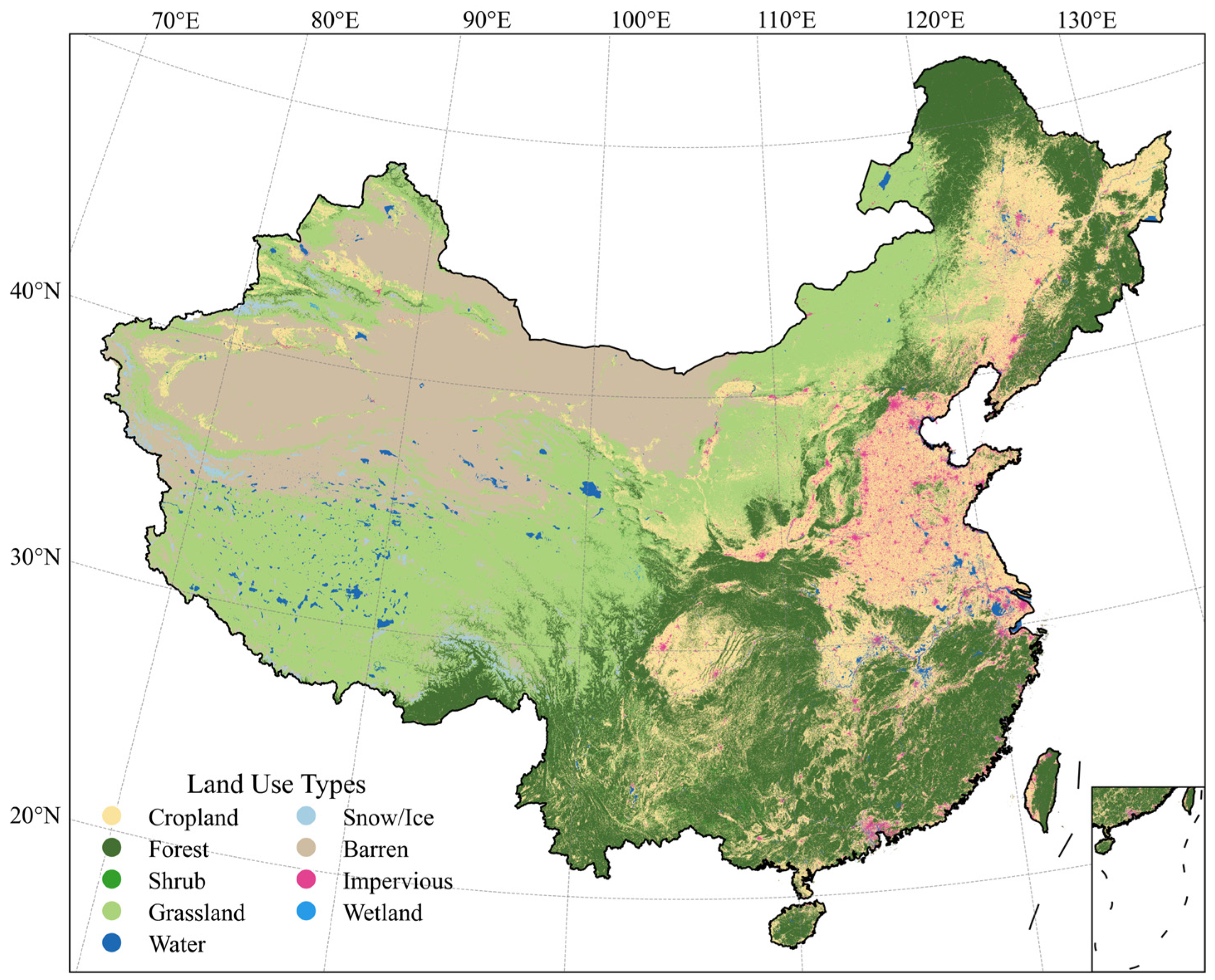
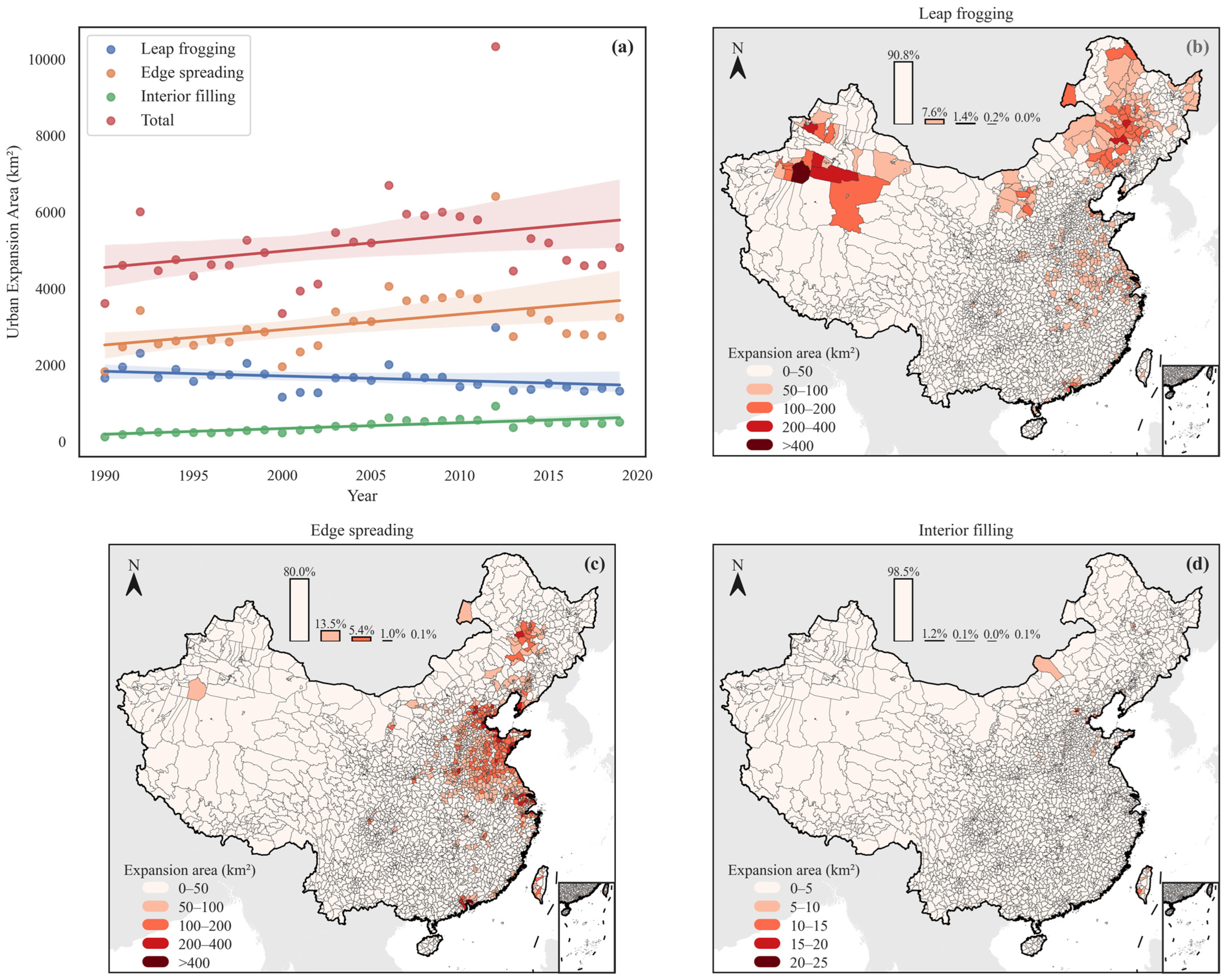

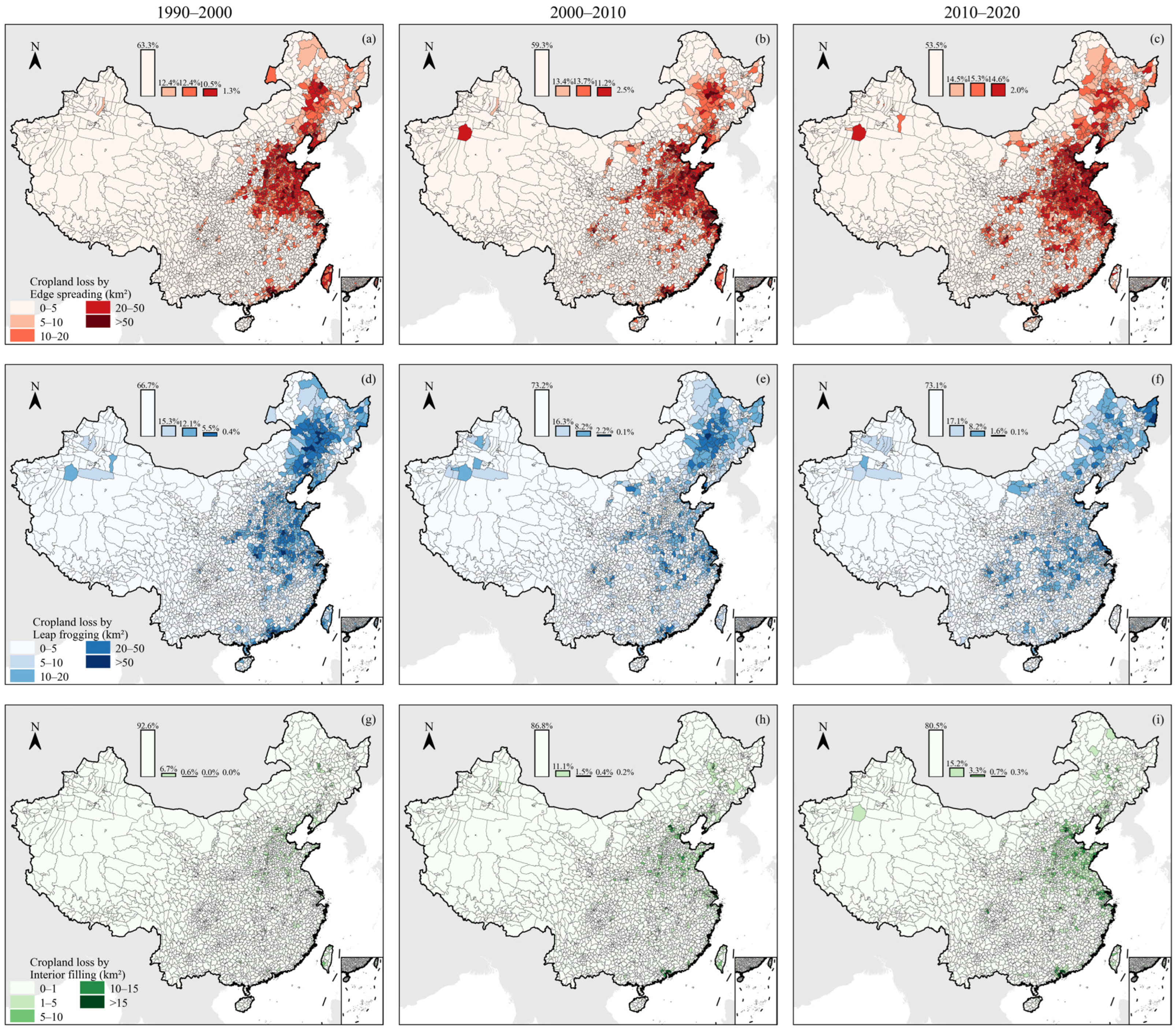
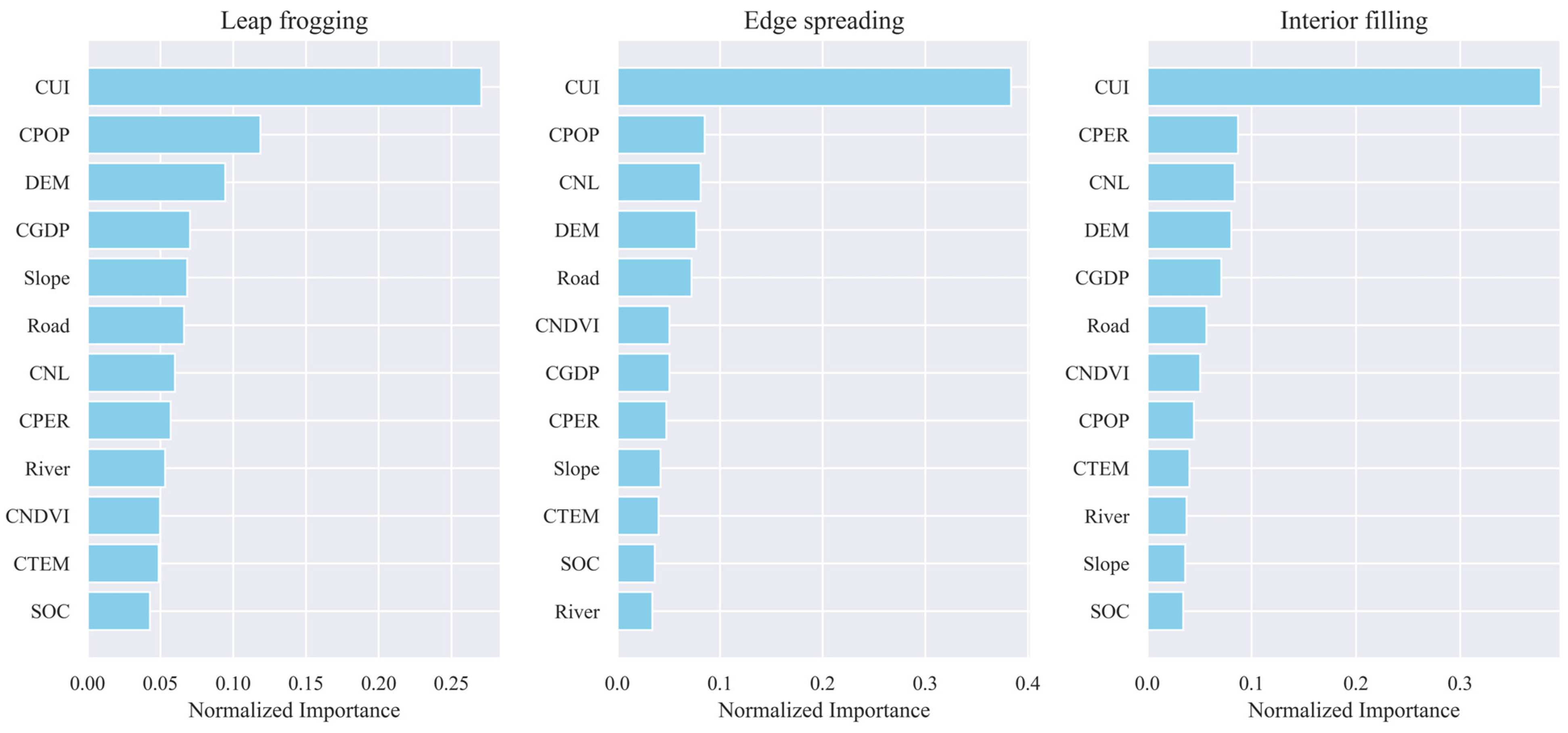
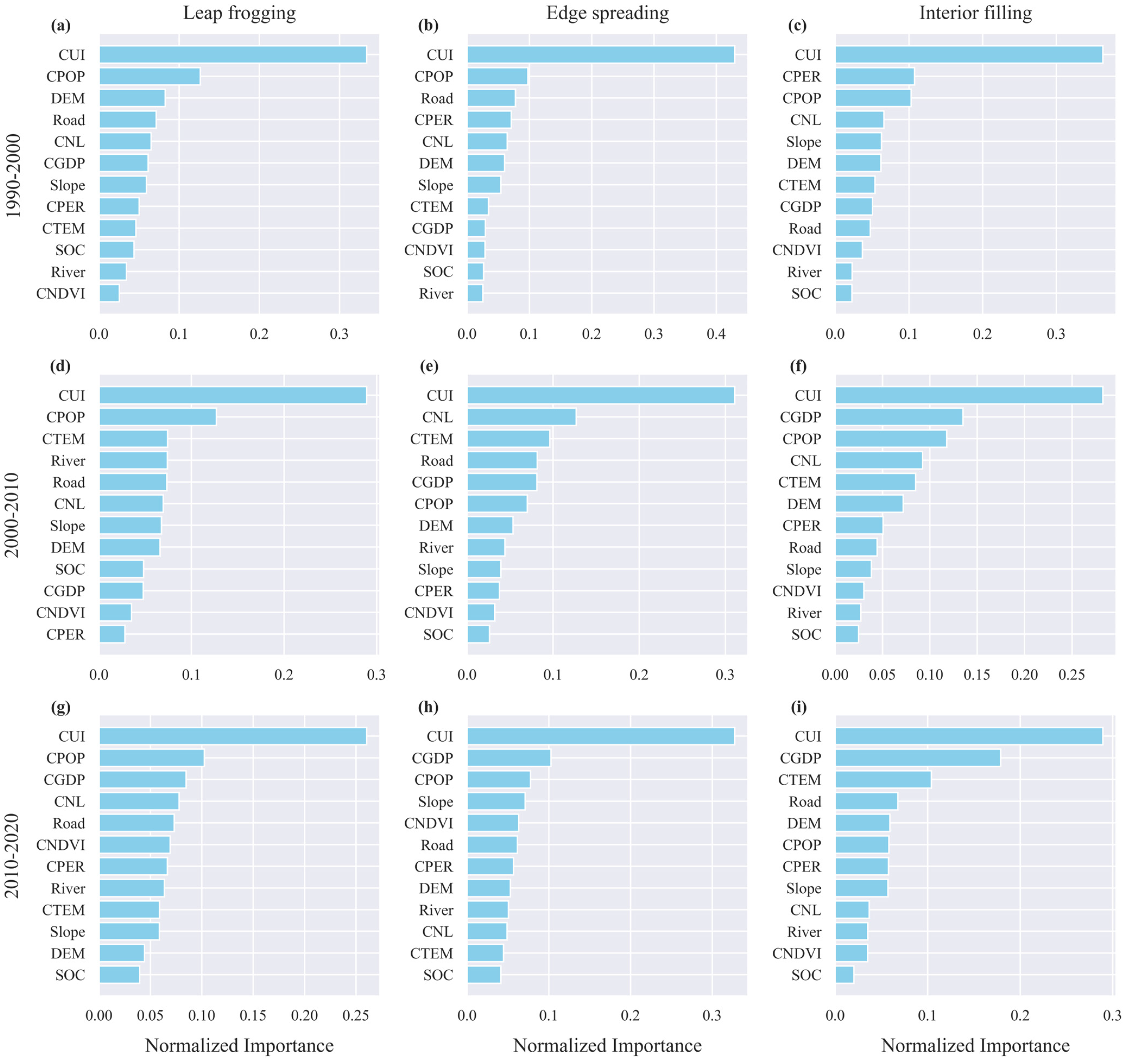
| Leap-Frogging/km2 | Edge-Spreading/km2 | Interior Filling/km2 | Total/km2 | |
|---|---|---|---|---|
| 1990–2000 | 16,587 | 22,328 | 915 | 39,830 |
| 2000–2010 | 12,236 | 26,981 | 1767 | 40,984 |
| 2010–2020 | 11,719 | 29,240 | 2794 | 43,753 |
| Total | 40,542 | 78,549 | 5476 | 124,567 |
Disclaimer/Publisher’s Note: The statements, opinions and data contained in all publications are solely those of the individual author(s) and contributor(s) and not of MDPI and/or the editor(s). MDPI and/or the editor(s) disclaim responsibility for any injury to people or property resulting from any ideas, methods, instructions or products referred to in the content. |
© 2025 by the authors. Licensee MDPI, Basel, Switzerland. This article is an open access article distributed under the terms and conditions of the Creative Commons Attribution (CC BY) license (https://creativecommons.org/licenses/by/4.0/).
Share and Cite
Mao, C.; Feng, S.; Zhou, C. Cropland Loss Under Different Urban Expansion Patterns in China (1990–2020): Spatiotemporal Characteristics, Driving Factors, and Policy Implications. Land 2025, 14, 343. https://doi.org/10.3390/land14020343
Mao C, Feng S, Zhou C. Cropland Loss Under Different Urban Expansion Patterns in China (1990–2020): Spatiotemporal Characteristics, Driving Factors, and Policy Implications. Land. 2025; 14(2):343. https://doi.org/10.3390/land14020343
Chicago/Turabian StyleMao, Chengrui, Shanshan Feng, and Canfang Zhou. 2025. "Cropland Loss Under Different Urban Expansion Patterns in China (1990–2020): Spatiotemporal Characteristics, Driving Factors, and Policy Implications" Land 14, no. 2: 343. https://doi.org/10.3390/land14020343
APA StyleMao, C., Feng, S., & Zhou, C. (2025). Cropland Loss Under Different Urban Expansion Patterns in China (1990–2020): Spatiotemporal Characteristics, Driving Factors, and Policy Implications. Land, 14(2), 343. https://doi.org/10.3390/land14020343






